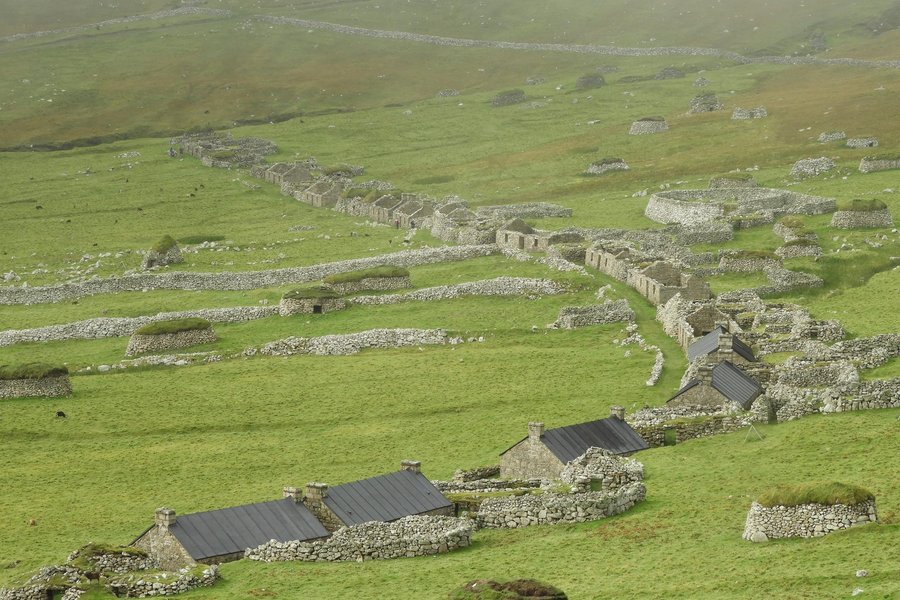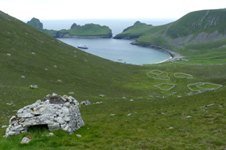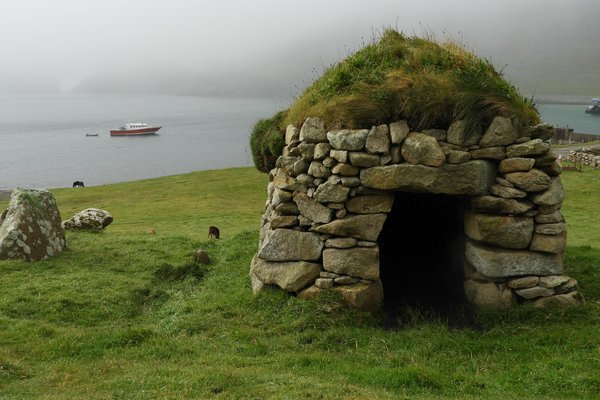United Kingdom
St. Kilda
St. Kilda is a remote and uninhabited archipelago in Scotland's Outer Hebrides, renowned as a seabird breeding station and for its past human occupation in extreme conditions.
The volcanic origins produced a dramatic landscape of exceptional cliffs and underwater scenery. The islands were occupied by humans for some 2,000 years, relying on bird products and the keeping of sheep. The remains of 4 settlements are left, the structures dating mostly to the 19th century. The last remaining people asked to be evacuated in 1930 due to a lack of resources to survive. Over 1 million seabirds use the islands, especially gannets, puffins and fulmars.
Community Perspective: It takes good planning beforehand and suitable weather on the day of departure, as it takes at least 2.5 hours across the sea to reach. The best point of departure is Harris, but you can also take it in as part of a longer Expedition Cruise like Solivagant did. Avoid departing from Skye, for reasons described by Nan.
Site Info
Official Information
- Full Name
- St. Kilda (ID: 387)
- Country
- United Kingdom
- Status
-
Inscribed 1986
Site history
History of St. Kilda
- 2005: Criteria
- Extended with Cultural criteria III and V
- 2004: Criteria
- Added Natural Criterion II (very high bird densities)
- 2004: Extended
- To include the surrounding marine area of 23,346.8 ha
- 1986: Inscribed
- Inscribed
- Type
- Mixed
- Criteria
- iii
- v
- vii
- ix
- x
Links
- UNESCO
- whc.unesco.org
- Official
-
- kilda.org.uk — St. Kilda - National Trust for Scotland
All Links
UNESCO.org
- whc.unesco.org — whc.unesco.org/
Official Website
- kilda.org.uk — St. Kilda - National Trust for Scotland
News Article
- Oct. 1, 2025 bbc.com — New call to stop rare sheep breed 'starving to death' on St. Kilda
- June 30, 2023 bbc.com — Effort to conserve water on remote World Heritage site
- Dec. 7, 2022 scotsman.com — 'Bucket list' St Kilda to tackle growing visitor numbers
- Feb. 13, 2021 bbc.com — Evidence St Kilda was inhabited 2,000 years ago
- July 22, 2020 pressandjournal.co.uk — Trust urges visitors not to travel to St Kilda
- Jan. 1, 2019 wirralglobe.co.uk — Researchers capture ‘stunning’ images of St Kilda sea caves
- Aug. 17, 2016 scotsman.com — Plans for St Kilda Centre at remote World Heritage Site
- June 20, 2016 theguardian.com — Fundraising drive aims to save seabird paradise off Scotland
- April 21, 2016 stornowaygazette.co.uk — New protections come into force for the seas around St Kilda
- Nov. 2, 2015 bbc.com — New book challenges St Kilda's 'lost world' tag
- Feb. 28, 2015 stornowaygazette.co.uk — New milestone for St Kilda Centre in Uig
- July 7, 2014 news.stv.tv — Bat discovered on St Kilda for the very first time
- Aug. 18, 2009 news.scotsman.com — Tourists are stealing St Kilda
- June 20, 2009 news.bbc.co.uk — Concerns about the impact a withdrawal of staff from a radar station will have on St Kilda
- Sept. 22, 2008 theherald.co.uk — Supply of drinking water restored at St. Kilda
- July 24, 2008 news.bbc.co.uk — St Kilda wreck to stay until 2009
- Feb. 3, 2008 telegraph.co.uk — Conservation experts warned that rodents aboard a trawler which hit rocks off the archipelago of St Kilda could devastate the island's rare sea bird colonies.
Community Information
- Community Category
- Natural landscape: Insular
- Cultural Landscape: Relict
Travel Information
Needs a Ferry
Reservation required
Recent Connections
-
Oceanic Dolphins
Common Bottlenose, Risso’s, Common, Whi…
-
Perfect Inscriptions
1986 -
Endemic Species that include the WHS name
St Kilda Field Mouse (Sub species - Apo…
Connections of St. Kilda
- Geography
-
-
Atlantic Ocean
-
Archipelagos
(Volcanic and erosion) 3 main islands plus stacs and outcrops -
Marine sites
The archipelago was originally inscribed with a land area of 854.6 ha. The 2004 extension to cover Cultural Criteria and an extra Natural criterion added a marine area of 23,346.8 ha. giving a total marine area of c 96% -
Uninhabited islands
Regarding Hirta: except for staff of radar tracking station, Trust and Scottish National Heritgae staff and scientific researchers -
Formerly inhabited islands
-
Located at an 'extreme point' of Latitude or Longitude
Soay on St Kilda is the westernmost point of UK (counting "Rockal" as a "rock)" . Hirta was the most westerly inhabited point
-
- Trivia
-
-
On Banknotes
Sir Alexander Fleming and St Kilda - 5 Scottish pounds - 2009See www.hnb.hr
-
Pareidolia
Stac Levenish - Its north cliff appears to have the profile of a human face, visible when travelling to St Kilda from the east (wiki) -
Cultural sites taking up an entire island
-
- History
-
-
Neolithic age
"Recently, the first direct evidence of earlier Neolithic settlement emerged?shards of pottery of the Hebridean ware style, found to the east of the village."
-
- Ecology
-
-
Peat
Cleits - small drystone structures - were used to store peat and turf which were both used as fuel -
Sea Stacks
Stac an Armin -
Endemic Species that include the WHS name
St Kilda Field Mouse (Sub species - Apodemus sylvaticus hirtensis - named after the Island of Hirta)See en.wikipedia.org
-
Oceanic Dolphins
Common Bottlenose, Risso’s, Common, White-beaked, Atlantic White-sided dolphins, Orca (UNEP-WCMC)
-
Endemic Bird Species
St Kilda Wren (sub species) -
Feral Animals
BoreraySee en.wikipedia.org
-
Natural Arches and Bridges
Stac Shoaigh natural arch -
Tundra
Habitats include ... dwarf shrub moss tundra (AB ev IUCN) -
Whales
minke and killer whales -
Seals
harbour seal, grey seal
-
- Architecture
-
-
Dry Stone Construction
From the evaluation document "The most common traditional structure on St. Kilda is the cleit, of which about 1260 have been recorded on Hirta, distributed all over the island, and more than 170 others on the outlying islands and stacs. Cleits are small drystone structures of round-ended rectilinear form, with drystone walls and a roof of slabs covered with earth and turf."
-
- Damaged
-
-
Ghost towns
"..abandoned since 1930. When the last residents of the United Kingdom’s remotest islands requested evacuation to the mainland, they left behind a traditional Scottish coastal village which now lies in ruins." -
'Threatened' by Infestation of Rats
-
Damaged in World War I
"a German submarine arrived in Village Bay on the morning of 15 May 1918 and after issuing a warning, started shelling the island. Seventy-two shells in all were fired and the wireless station was destroyed. The manse, church and jetty storehouse were also damaged but there was no loss of life" (Wiki)
-
- World Heritage Process
-
-
Mixed sites inscribed on 5 or more criteria
Criteria: iii/v/vii/ix/x. 2 Cultural, 3 Natural -
Extended
2004: To include the surrounding marine area of 23,346.8 ha -
Mixed and Cultural Landscape
Relict CL -
Perfect Inscriptions
1986 -
Marine extension
2004: to include the surrounding marine area of 23,346.8 ha -
Mixed sites which became so after original inscription
Natural extended to Cultural
-
- Religion and Belief
-
-
Protestantism
"In 1822, the Reverend John MacDonald, a renowned evangelical preacher, the 'Apostle of the North', visited St. Kilda. He set about the foundations of a puritanical religion, built upon by the Reverend Neil MacKenzie who arrived as resident minister in 1830." (AB ev)
-
- Human Activity
-
-
Hunting or harvesting of Birds
The collection of Gannets and their eggs was a significant aspect of St Kildan culture and economy. -
Viking settlements
"It is certain that the Vikings visited and may have settled the islands." (AB ev) -
Pastoralism
subsistence economy based on the products of birds, agriculture and sheep farming; reflecting age-old traditions (AB ev)
-
- Constructions
-
-
Sites of Parliament
"The people of St Kilda, a Gaelic-speaking population, lived under their own form of democracy with an informal meeting held every weekday morning in the village street. It was known as the 'St Kilda Parliament' and consisted of all the adult males on the island."
-
- WHS on Other Lists
-
-
Memory of the World
Film "St Kilda, Britain's Loneliest Isle" (2010) -
Located in a TCC Territory
Scotland
-
- Timeline
-
-
Paleocene
Created as part of the British Tertiary Volcanic province during the volcanic activity of the Palaeocene and early Eocene (c63-52Ma) which accompanied the early stages of the opening of the N Atlantic.See www.kilda.org.uk
-
Built in the 1st century
first occupation
-
- Visiting conditions
-
-
Needs a Ferry
Day trips sail from Skye and the Western Isles. You have to make yourself available for a two-day slot, and they sail on the first suitable day of that slot. It's a 3- to 4-hour crossing. (wikivoyage) -
Reservation required
From one of the boat companies, a few weeks ahead (months if you need a specific date in summer)
-
News
- bbc.com 10/01/2025
- New call to stop rare sheep breed …
- bbc.com 06/30/2023
- Effort to conserve water on remote…
- scotsman.com 12/07/2022
- 'Bucket list' St Kilda to tackle g…
Community Reviews
Show full reviews
Our 2019 meetup location was supposed to be St. Kilda. As pointed out by Els in her blog post, the boat didn't go. I think in the process we gathered some valuable lessons learned and I would like to document them here.
Getting In
First things first: St. Kilda is an island roughly 100km off the coast of the Outer Hebrides in Scotland. The only way to get there is by boat. Several operators offer day trips. The trips are subject to cancellation as you are going out into the Atlantic ocean and the weather and the sea can be rough.
Boat trips are offered from the islands of Harris and Uist in the Outer Hebrides and from Skye in the Inner Hebrides. The distance from Skye is significantly longer than from Harris or Uist. Boats from Harris and Uist go from 8:00h to 19:00h with 4,5h to 5h on the islands. The boats from Skye travel from 7:00h to 20:00h with 4h on the island.
There are also some expensive cruises that visit the islands.
Getting There
If you travel by car, Skye is significantly easier as you can take a bridge. It takes less than 6h from Edinburgh to Skye by car. It takes nearly 9h to get to Harris or Uist as you need to take the ferry from Uig on Skye. If you are arriving from the North, the ferry would be in Ullapool. Note: Ferry times are tricky and you need a reservation, especially in …
Keep reading 0 comments
The previous reviews cover the 2 main ways of visiting St Kilda (Beyond having your own yacht!) – a day trip from Lewis and a longer (often c 1 week) small boat cruise of the area. In addition, however, there are a number of “Expedition Cruise” boats which take in the Islands as part of a larger (2 week) tour of UK islands or of the North Atlantic/Sub Arctic. We visited on one of the latter having set off the previous evening from Oban en route to Greenland. On arrival we were lucky to find a NW wind which left Village Bay reasonably well protected – our Zodiac landings at the little concrete pier were a bit bumpy but a planned cruise through the small gap between the islands of Hirta and Dun wasn’t possible with large Atlantic waves crashing through. The risk of not being able to land at St Kilda is high – the summer season day trips are scheduled on alternate days to provide a cushion against bad weather and you need to allow for delayed departures in your plans.
St Kilda is often stated to be the most remote island group on the British Isles ever to have been inhabited but in fact the island of North Rona is further from the nearest other land (c44 miles v 40). The latter (which our tour visited on the following day) contains early Christian remains dating back to 7th/8th century but lost its permanent population around 1844. St …
Keep reading 0 comments
St. Kilda is easily in my top three WHS! What a truly amazing place.
Planning for the trip took some time, as indeed did getting there. We visited Easter 2009 and had booked passage on the first boat trip of the year. We gave ourselves a 4 day window to make the journey - in the end we had to extend our stay on the Outer Hebrides to make the trip due to poor weather.
The trip out and back is an experience in itself. The approach to the islands reminded me of the Skellig islands WHS in Ireland. We had around 5 hours on St. Kilda followed by a cruise around some of the smaller islands.
The Natural Trust for Scotland guide on site meets visitors at the quay for a H&S briefing. They also man a small shop and post office where you can get a St. Kilda post mark and send mail via the weekly helicopter.
The village is quite special and the views from the peaks are amazing. There was plenty of wildlife and it was lambing season when we visited. Four of the houses have been refurbished; one is now an excellent museum. St. Kilda is a little spoilt by the ugly military instillations unfortunately.
St. Kilda was certainly my most expensive WHS visited, however the trip was well worth all the effort and I would go back again in a heartbeat.
Keep reading 0 comments
Planning for my journey started the previous year following a visit to the Isles of Lewis and Harris for the first time. I stayed at Cairisiadar with Jessie Buchanan in an excellent bed & breakfast overlooking Loch Roag on the west coast of Lewis. Here I met a lady who was I believe in her 70’s who had travelled from Aberdeen and on her way to St.Kilda. Until then I hadn't even heard of this place! She kindly left me a leaflet " Cruising with the MV Cuma".
The weather had not been too kind of late but the day that she was leaving for St.Kilda cleared with sunshine late in the day but with a near gale force wind blowing. I remember seeing the MV Cuma leave and cruise across West Loch Roag heading for the open sea – I took one photograph. At the time I did not think too much about actually going to this remote island but as time went on I became fascinated with the story and struggle of St.Kilda as have so many other people.
I read up about the islands, bought books, searched the internet and sought out articles and especially photographs. I decided that I wanted to go on this "adventure" and booked with Murdo for a trip in June – 6 days in total staying on the Cuma. I had never previously travelled in a boat other than a scenic trip for a few hours let alone across the atlantic.
The …
Keep reading 0 comments
